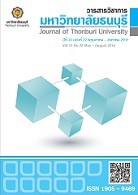Title : การจัดการสภาพคล่องทางการเงินสำหรับ ผู้ประกอบการ SMEs ภายใต้วิกฤตเศรษฐกิจโลก : Financial liquidity Management for SMEs Entrepreneurs in World Economic Crisis
Researcher : สุรชัย ภัทรบรรเจิด
Surachai Pattarabanjird
Department : Faculty of Business Administration , Siam University, Bangkok, Thailand
E-mail : spsmart99@hotmail.com
บทคัดย่อ : บทความนี้เขียนขึ้นเพื่อเป็นแนวทางให้ผู้ประกอบการ SMEs ผู้ประกอบการขนาดใหญ่ สถาบันการเงินและหน่วยงานรัฐที่เกี่ยวข้องได้ร่วมกันในการวางแผนและดำเนินการช่วยเหลือผู้ประกอบการ SMEs ซึ่งเป็นกลไกสำคัญของการพัฒนาเศรษฐกิจของประเทศทั้งในด้านการจ้างงาน การเชื่อมโยงการค้ากับผู้ประกอบการขนาดใหญ่ และการกระจายความเจริญไปยังส่วนภูมิภาคโดยได้กล่าวถึงแนวทางในการนำองค์ความรู้ในการบริการสภาพคล่องทางการเงินในด้านการบริหารเงินสดและการบริหารทุนหมุนเวียนไปปฏิบัติ นอกจากนี้ได้กำหนดข้อเสนอแนะเชิงนโยบายในการวางแผนช่วยเหลือผู้ประกอบการ SMEs อย่างเป็นรูปธรรมต่อไป
วิกฤติการณ์ทางเศรษฐกิจของโลกที่เกิดขึ้นตั้งแต่อดีตจนถึงปัจจุบันไม่ว่าจะเป็นวิกฤติภาวะเงินฝืดของญี่ปุ่นซึ่งเกิดขึ้นมากว่า 20 ปี วิกฤติการณ์ทางการเงินในประเทศไทย ใน ปี พ.ศ. 2540 วิกฤตสินเชื่อซับไพรม์หรือวิกฤติแฮมเบอร์เกอร์ ในปี พ.ศ.2551วิกฤติหนี้สาธารณะของกรีซ ในปี พ.ศ. 2554 วิกฤติเศรษฐกิจของตลาดหุ้นของจีน ในปี พ.ศ. 2557 และวิกฤติภาวะค่าเงินรูเบิลของรัสเซีย ในปี พ.ศ. 2557 วิกฤติการณ์เหล่านี้ล้วนส่งผลกระทบอย่างรุนแรงต่อผู้ประกอบการไทย โดยเฉพาะผู้ประกอบการ SMEs โดยผลกระทบที่สำคัญ คือ ผลกระทบต่อการรักษาสภาพคล่องทางการเงิน อันเป็นสาเหตุสำคัญที่ทำให้ผู้ประกอบการ SMEs ต้องประสบปัญหาในการดำเนินกิจการและบางรายต้องเลิกกิจการไปในที่สุด
ดังนั้นการให้องค์ความรู้ในทางปฏิบัติได้จริงให้กับผู้ประกอบการ SMEs ในการจัดการสภาพคล่องจึงเป็นสิ่งสำคัญอย่างยิ่ง ทั้งในด้านการบริหารเงินสดโดยการเร่งเงินสดรับเข้า ชะลอการจ่ายเงินสดและการดำรงรักษาเงินสดขั้นต่ำการบริหารทุนหมุนเวียนผ่านแนวนโยบาย 3 รูปแบบ คือ 1. นโยบายแบบสมดุล 2. นโยบายแบบระมัดระวัง และ 3. นโยบายแบบกล้าเสี่ยง ในขณะที่สถาบันการเงินและหน่วยงานภาครัฐโดยเฉพาะอย่างยิ่ง สถาบันการเงินเฉพาะกิจของรัฐ จะต้องมีมาตรการและนโยบายในการช่วยเหลือผู้ประกอบการ SMEs ผ่านทางนโยบายอัตราดอกเบี้ย นโยบายด้านภาษี และมาตรการในการสร้างความเข้มแข็งในระยะยาวอื่นๆ เช่น การสร้างเครือข่ายผู้ประกอบการ SMEs การจัดหาแหล่งทุน การสร้างนวัตกรรมให้กับผู้ประกอบการ SMEs ผ่านการวิจัยและพัฒนา เป็นต้น แนวทางทั้งหมดที่กล่าวมาจะเป็นการส่งเสริมและสร้างความเข้มแข็งให้กับผู้ประกอบการ SMEs ให้สามารถแข่งขันในตลาดโลกได้และนำไปสู่การสร้างความเข้มแข็งให้กับเศรษฐกิจของประเทศไทยในระยะยาวให้เติบโตอย่างมั่งคั่งและยั่งยืนต่อไป
คำสำคัญ : ผู้ประกอบการ SMEs, วิกฤติการณ์เศรษฐกิจโลก, การจัดการสภาพคล่อง, การบริหารเงินสด, การบริหารทุนหมุนเวียน
Abstract : The objective of this paper was to find a guideline for SMEs entrepreneurs, LEs entrepreneurs, financial institutions and related government sectors to help SMEs. SMEs are crucial mechanisms to develop Thais economy especially employment, trade networking with LEs entrepreneurs and spread prosperity to regional area. This paper acknowledged SMEs entrepreneurs about financial liquidity management especially on cash management and working capital management. Moreover, it also suggested policy planning for LEs entrepreneurs, Financial institutions and Government sectors in order to assist SMEs entrepreneurs.
World economic crises occurred several times such as the deflation crisis in Japan occurred for more than 20 years, Financial crisis in Thailand in 1997, and the sub-prime crisis in U.S.A in 2007, the public debt crisis in Greece in 2011, the capital market crash in China in 2014 and the Ruble crisis in Russia in 2014. These crises, therefore, have caused severe impacts to many Thai entrepreneurs, especially to SMEs. The major impact was the problem of financial liquidity that caused SMEs to shut down their businesses.
Hence, providing practical knowledge to SME entrepreneurs for managing their liquidity both cash management and working capital management was important. For cash management, this paper recommended to accelerate cash-inflow, decelerate cash-outflow and maintain minimum cash balance, and for working capital management, the paper suggested three policies; 1. Hedging, 2. Conservative, and 3. Aggressive. Simultaneously, the financial institutions and the government sectors must also offer entrepreneurs policies or measures of assistance through interest rate policy, tax policy, and long term strengthening measures namely; building SMEs networking, fund raising for SMEs, and innovation for SMEs by way of R&D policy. All of these policies and measures will promote and strengthen SMEs of Thai entrepreneurs to be able to compete in the world market, and drive Thai economy to grow securely and sustainably.
Keywords : SMEs entrepreneurs, world economic crises, financial liquidity, management, cash management, working capital management
Publication : วารสารวิทยาลัยบัณฑิตศึกษาการจัดการ มหาวิทยาลัยขอนแก่น ปีที่ 9 ฉบับที่ 1 มกราคม-มิถุนายน 2559 MBA-KKU Journal Vol.9 No.1 Jan-Jun 2016
Link to Publication: https://www.tci-thaijo.org/index.php/mbakkujournal/issue/view/5998
Bibliography : สุรชัย ภัทรบรรเจิด. (2559). การจัดการสภาพคล่องทางการเงินสำหรับ ผู้ประกอบการ SMEs ภายใต้วิกฤตเศรษฐกิจโลก. วารสารวิทยาลัยบัณฑิตศึกษาการจัดการ มหาวิทยาลัยขอนแก่น, 9(1), 281-303.





